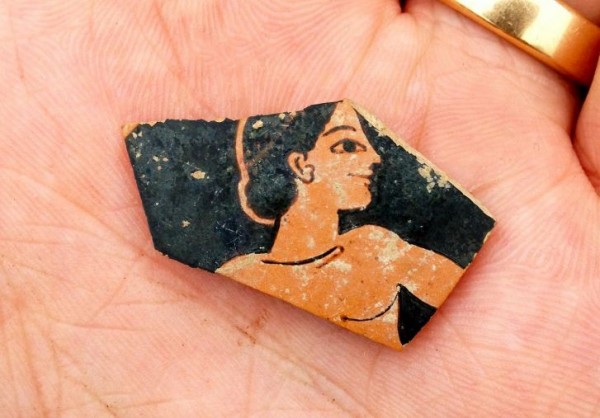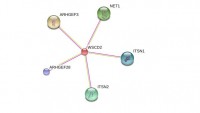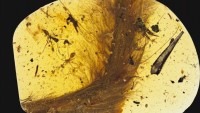Greek and Swedish Archaeologists Discover Unknown City in Greece
| Arthur Dominic Villasanta | | Dec 14, 2016 10:42 AM EST |
(Photo : SIA/EFAK/YPPOA) Fragment of red-figure pottery from the late 6th century BC, probably by Attic painter Paseas.
An international research team at the Department of Historical Studies, University of Gothenburg, in Sweden is exploring the remains of an ancient city in central Greece.
Archaeologists from the university have begun exploring a previously unknown ancient city at a village named Vlochós, five hours north of Athens. The archaeological remains are scattered on and around the Strongilovoúni hill on the great Thessalian plains and can be dated to several historical periods.
Like Us on Facebook
The discovery can change the view of an area traditionally considered a backwater of the ancient world.
"What used to be considered remains of some irrelevant settlement on a hill can now be upgraded to remains of a city of higher significance than previously thought, and this after only one season," said Robin Rönnlund, PhD student in Classical Archaeology and Ancient History at the University of Gothenburg and leader of the fieldwork.
"A colleague and I came across the site in connection with another project last year, and we realized the great potential right away. The fact that nobody has never explored the hill before is a mystery."
The Vlochós Archaeological Project (VLAP) was organized with the aim of exploring the remains. The project's research team completed the first field season during two weeks this September.
VLAP is a collaboration between the Ephorate of Antiquities of Karditsa and the Swedish Institute at Athens. In 2016-2017, a team of researchers from the University of Gothenburg and University of Bournemouth is exploring the remains of a city in Vlochós as part of the project.
Rönnlund said the hill on which the ruins of Vlochós stands hides many secrets. Remains of towers, walls and city gates can be found on the summit and slopes, but hardly anything is visible on the ground below.
The ambition is to avoid excavation and instead use methods such as ground-penetrating radar to enable the team to leave the site in the same shape as it was in when they arrived. The success of this approach is evident from the results of the first field season.
"We found a town square and a street grid that indicate that we are dealing with quite a large city. The area inside the city wall measures over 40 hectares. We also found ancient pottery and coins that can help to date the city.
"Our oldest finds are from around 500 BC, but the city seems to have flourished mainly from the fourth to the third century BC before it was abandoned for some reason, maybe in connection with the Roman conquest of the area."
Rönnlund believes that the Swedish-Greek project can provide important clues as to what happened during this violent period in Greek history.
"Very little is known about ancient cities in the region, and many researchers have previously believed that western Thessaly was somewhat of a backwater during Antiquity. Our project therefore fills an important gap in the knowledge about the area and shows that a lot remains to be discovered in the Greek soil."
TagsVlochós, Greece, University of Gothenburg, Strongilovoúni hill, Robin Rönnlund, Ephorate of Antiquities of Karditsa
©2015 Chinatopix All rights reserved. Do not reproduce without permission
EDITOR'S PICKS
-

Did the Trump administration just announce plans for a trade war with ‘hostile’ China and Russia?
-

US Senate passes Taiwan travel bill slammed by China
-

As Yan Sihong’s family grieves, here are other Chinese students who went missing abroad. Some have never been found
-

Beijing blasts Western critics who ‘smear China’ with the term sharp power
-

China Envoy Seeks to Defuse Tensions With U.S. as a Trade War Brews
-

Singapore's Deputy PM Provides Bitcoin Vote of Confidence Amid China's Blanket Bans
-

China warns investors over risks in overseas virtual currency trading
-

Chinese government most trustworthy: survey
-

Kashima Antlers On Course For Back-To-Back Titles
MOST POPULAR
LATEST NEWS
Zhou Yongkang: China's Former Security Chief Sentenced to Life in Prison

China's former Chief of the Ministry of Public Security, Zhou Yongkang, has been given a life sentence after he was found guilty of abusing his office, bribery and deliberately ... Full Article
TRENDING STORY

China Pork Prices Expected to Stabilize As The Supplies Recover

Elephone P9000 Smartphone is now on Sale on Amazon India

There's a Big Chance Cliffhangers Won't Still Be Resolved When Grey's Anatomy Season 13 Returns

Supreme Court Ruled on Samsung vs Apple Dispute for Patent Infringement

Microsoft Surface Pro 5 Rumors and Release Date: What is the Latest?













